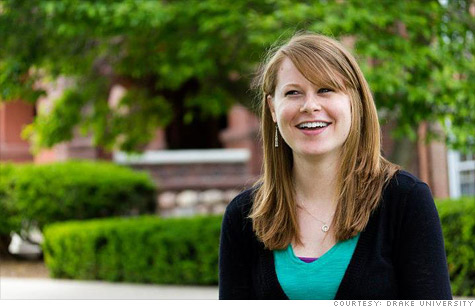Search News

Bette Wiebke majored in actuarial science and had a job lined up long before she graduated. Click the photo for more college majors that are high in demand.
NEW YORK (CNNMoney) -- What if every person who wanted a job had one?
The entire United States may never be able to reach a 0% unemployment rate. But on a smaller scale, it's not entirely unheard of.
Simply put, 0% unemployment can occur when everyone who is looking for a job has one. It can happen in niche markets when there are more openings than there are workers to fill them.
Such was the case with Monaco. According to the CIA, the country had a 0% unemployment rate in 2005. The tiny nation -- which is smaller than a square mile -- has to import workers from neighboring France in order to fill the demand for service jobs at the local upscale casinos and hotels.
In the U.S., college grads who studied astrophysics, geophysics, pharmacology and actuarial science had zero unemployment in 2010, according to the Georgetown University Center on Education and the Workforce.
In these small and highly-skilled fields, many recent grads have job offers before they graduate.
That was the case for Bette Wiebke, who just graduated with a bachelor's in actuarial science from Drake University. She's had a job lined up with Travelers Insurance since September.
"The fact that most of us can get jobs coming straight out of college, definitely says something good about the occupation," Weibke said.
While obviously not all students find jobs right away, those who don't often choose to go on to grad school, and aren't counted as unemployed during their studies. About 97% of Drake University actuarial grads either have a job or internship, or are enrolled in grad school within six months of graduating.
"It's hard to imagine there would be zero percent unemployment in any field, but for certain segments, there is much higher demand for workers than there is supply," said Kerry Boehner, founder of KOB Solutions, a Pittsburgh-based recruiting firm.
The balance of jobs and workers can quickly change as more people enter markets with little-to-no unemployment. That's why Boehner cautions young people not to choose a career track in an advanced specialty simply because it's currently in demand.
"If you're going to school for 11 years, what's hot now may not be hot in 11 years," she said.
The U.S. job market currently has 8.1% unemployment. While almost everyone agrees that's too high, zero unemployment wouldn't be a good thing either.
An economy with no unemployment is like a stagnant real estate market, said University of Oregon professor Mark Thoma.
"Suppose every apartment in the country is full, and I wanted to move from New York to Los Angeles," he said. "I would have to find someone in L.A. who wants to move to New York, and we would have to do a trade. It's much more efficient to have some vacancies."
Some churn in the labor market is a sign of a healthy economy, said Chris Pissarides, a Nobel Prize winning economist at the London School of Economics. He estimates that even in the best of times, regular turnover in the job market leads to an unemployment rate around 5%.
Add on structural changes that can put people out of work -- for example construction workers after the housing bust -- and full employment is probably somewhere around an unemployment rate of 6%.
"In an economy that is really growing fast, there's always a need to reallocate workers either across the country, skill categories or industries. People may need to change jobs," Pissarides said.
"Therefore we have to accept there will always be some unemployment and it's good for the economy."
Nearly half of American workers decide not to take most of their vacation days. Are you one of them? Email realstories@turner.comand you could be featured in an upcoming article on CNNMoney. ![]()
| Overnight Avg Rate | Latest | Change | Last Week |
|---|---|---|---|
| 30 yr fixed | 3.80% | 3.88% | |
| 15 yr fixed | 3.20% | 3.23% | |
| 5/1 ARM | 3.84% | 3.88% | |
| 30 yr refi | 3.82% | 3.93% | |
| 15 yr refi | 3.20% | 3.23% |
Today's featured rates:
| Latest Report | Next Update |
|---|---|
| Home prices | Aug 28 |
| Consumer confidence | Aug 28 |
| GDP | Aug 29 |
| Manufacturing (ISM) | Sept 4 |
| Jobs | Sept 7 |
| Inflation (CPI) | Sept 14 |
| Retail sales | Sept 14 |